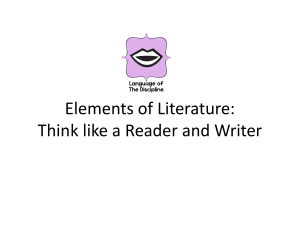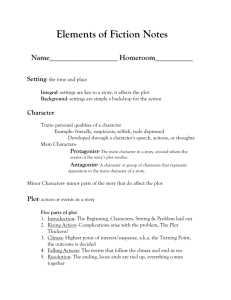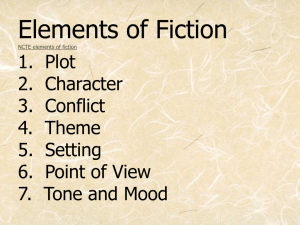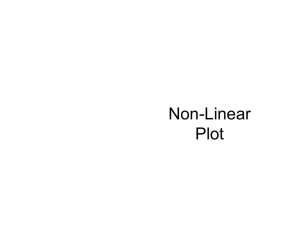Short Stories Notes
advertisement
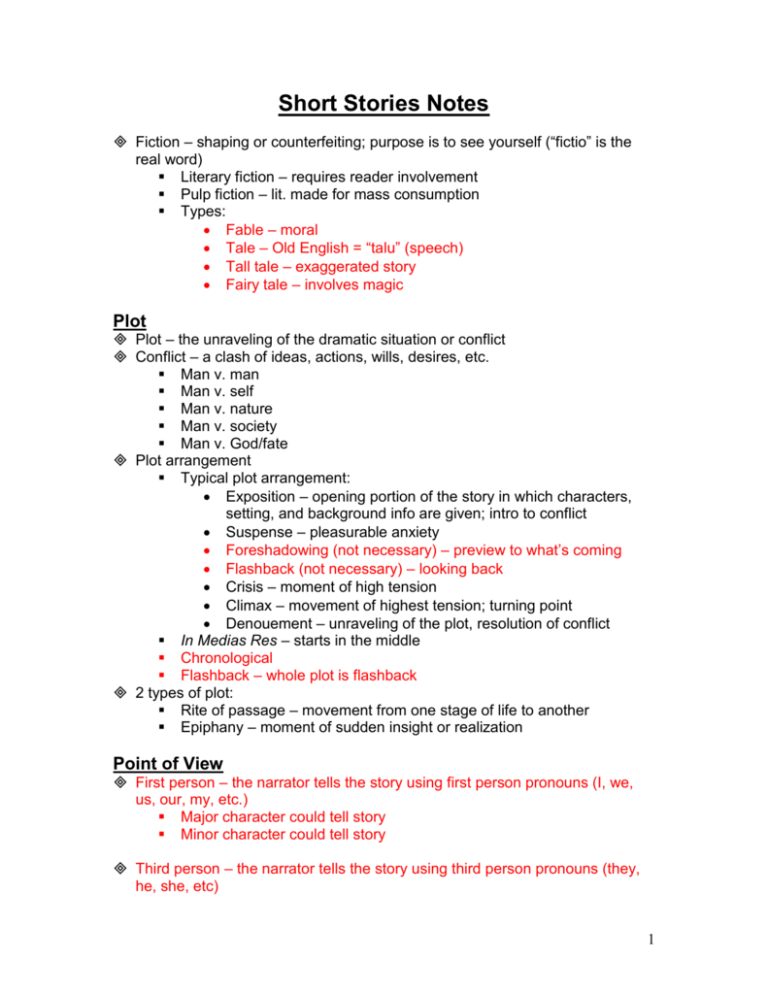
Short Stories Notes Fiction – shaping or counterfeiting; purpose is to see yourself (“fictio” is the real word) Literary fiction – requires reader involvement Pulp fiction – lit. made for mass consumption Types: Fable – moral Tale – Old English = “talu” (speech) Tall tale – exaggerated story Fairy tale – involves magic Plot Plot – the unraveling of the dramatic situation or conflict Conflict – a clash of ideas, actions, wills, desires, etc. Man v. man Man v. self Man v. nature Man v. society Man v. God/fate Plot arrangement Typical plot arrangement: Exposition – opening portion of the story in which characters, setting, and background info are given; intro to conflict Suspense – pleasurable anxiety Foreshadowing (not necessary) – preview to what’s coming Flashback (not necessary) – looking back Crisis – moment of high tension Climax – movement of highest tension; turning point Denouement – unraveling of the plot, resolution of conflict In Medias Res – starts in the middle Chronological Flashback – whole plot is flashback 2 types of plot: Rite of passage – movement from one stage of life to another Epiphany – moment of sudden insight or realization Point of View First person – the narrator tells the story using first person pronouns (I, we, us, our, my, etc.) Major character could tell story Minor character could tell story Third person – the narrator tells the story using third person pronouns (they, he, she, etc) 1 Omniscient – all seeing, all knowing Limited omniscient – knows and sees all about only one character Objective – fly on the wall; sees all, doesn’t know all; external Editorial omniscience – all seeing/knowing, also expresses a view Naive/innocent narrator (1st person) – Huckleberry Finn, Scout in To Kill a Mockingbird; doesn’t really understand what’s going on Unreliable narrator – takes ideas/facts from other characters; rumor, gossip Stream of consciousness – random thoughts Interior monologue – scripted words with one person’s thoughts interspersed Setting Time and place of the story Locale – physical environment (specific, such as what’s on the coffee table) Time – decade, century, season, day, time, passage of time (time frame/period) Other elements – weather, clothing Purposes Evoke atmosphere Reveal character – setting is often alike to character(s) Symbol Reveals tone (authors attitude) Reveals theme (universal truth) Character Methods of characterization Direct – author shows/tells straight out through exposition what the character is like (i.e.: the girls in “A&P”) Indirect – character is shown in action, and readers infer what the character is like from that action (i.e.: the characters in “The Storm”) Types of characters Three types: Flat – one-dimensional, easily described, limited to one or two traits Round – multi-dimensional, hard to analyze/summarize Stock/stereotype – has appeared so often in literature that readers immediately recognize the type Aspects of types: Static – same at end of text as at the beginning Dynamic – undergoes some sort of permanent change Believability: Consistent – can’t behave one way in a situation and a different way in another 2 Motivated – readers want to understand why characters do what they do, especially if there’s a change Plausible – lifelike; the character can’t be too good or too bad or an odd combination of both Change Within the possibilities of the character Sufficiently motivated by the action Sufficient time for the change to take place Names often reflect character Anti-hero – in post-modern literature; ordinary, 20th century citizen who is frustrated, mocked, confused Gratuitous act – action without cause/motivation Tone Tone – author’s attitude toward his audience, his subject matter, and himself as revealed through the work; emotional coloring of the work (i.e.: angry, frustrated, surprised, bemused unfulfilled, pathos [pathetic]) Mood – feeling the reader gets Look for tone in word choice, character’s response, setting Style Style – the individual traits/characteristics of a piece; the author’s way of managing words that seems habitual or customary Language/word choice – connotative or denotative, abstract or concrete, dialect Setting and characters Structure/syntax – sentence structure, repetition, dashes Use of imagery – show instead of tell Patterns of sound – alliteration, rhyme, consonance, assonance Figurative speech – simile, metaphor, personification Irony Irony – any matter of discrepancy Three major types: Verbal – discrepancy between what is said and what is meant o Sarcasm – verbal irony with a tinge of mockery Dramatic – discrepancy between what the character says/thinks and what the reader knows to be true Situational – discrepancy between anticipation/expectation and reality (what we expect is not what we get) Other types: Point of view – discrepancy between narrator and author Cosmic – fate causes discrepancy 3 Theme Theme – the underlying generalization about life in a story Can be stated in one sentence Should be universal, never story-specific Sometimes reflected in the title Never cliché Never moralistic Symbol Symbol – thing that suggests more than the literal Allegory – story with a meaning beneath the surface meaning Symbolic act – gesture of larger that usual significance 4

